More Fun Than a Pub Crawl, and You Get to Eat.
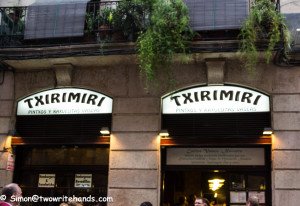
Basque Tapas Bar in El Born
To the casual eye, our group probably looked like any other knot of tourists exploring Barcelona, but history and architecture weren’t on the agenda. Maris, our Estonian-born Tapas Experience Tour guide, had promised us a WOW of an evening, and she was about to deliver on that promise.
A day of taking in Barcelona’s historical sites can work up an appetite, not to mention a powerful thirst. So, for Simon, Otto and me, sampling the wares of four of the city’s best tapas bars seemed a most fitting finale to a day of wondrous discoveries.
Tapas, commonly known as Spanish appetizers or snacks, are small plates of food served with drinks. In Spain, groups of friends often like to visit three or four tapas bars in an evening, enjoying beer, wine or sangria and sharing tapas in each one.
It may be hard to swallow, but today’s varied, and sometimes elaborate, tapas originated as a practical solution to an annoying problem., In order to keep flies out of drinks, alcoholic beverages were served with a small piece of bread covering the top of the glass. From this humble beginning, tapas evolved into the tasty treats now enjoyed in Spanish homes, bars and restaurants.
The tour took us to locations inEl Born and Barceloneta. We had seen these areas in full daylight, but with the approach of evening, there was a stir of anticipation in the air, as locals and visitors prepared to indulge themselves in Barcelona’s goldmine of tapas offerings.
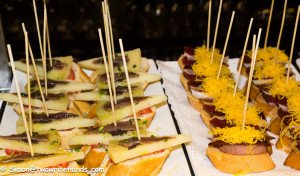
Two Types of Pintxo. The one on the Left is A Manchego Cheese and Anchovy and the Other is a Mixture of Meat and Cheese
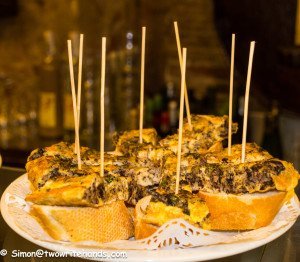
Meat and Egg Pie Pintxo

Soft Brie-like Cheese, with Manchego and Quince Jelly on the Left and Creamed Goat Cheese Pintxo on the Right
Our first stop was Txirimiri, an establishment that served traditional Basque tapas, called pintxo (pronounced pincho). Upon entering the bar, we were immediately tempted with an impossible selection of hot and cold savory combinations, each empaled on a slice of crusty bread by a long menacing-looking toothpick.
The purpose of the toothpick is not only to keep the pintxo from disintegrating when you try to eat, but a method of determining how much you owe when your ready to leave. So you need to keep your toothpicks on your empty plate, and bring them with you when you settle up. That means you don’t throw any of your toothpicks away, hide them or slide them onto someone else’s plate. This is an unique honor system that I hope at least most people honor.
Knowing that this was only our first opportunity to graze, Simon and I limited ourselves to two pintxos for soaking up our beer. One was an artful layering of the bread spread with soft creamy cheese, roasted red pepper, asparagus, hard-cooked egg and anchovy. The combination of flavors and textures was harmonious and mild, with a hit of saltiness from the fish.
Our second pintxo had the bread topped with a long piece of mild garlic and herb flavored sausage. It was served hot with no embellishments. This seemed appropriate, since the sausage definitely held its own.
Segons Mercat, a restaurant specializing in fresh fish and tapas, was our next feeding station. Maris told us the restaurant was a six time MICHELIN starred tapas bar, which served excellent and reasonably priced seafood at lunch. We tucked this information away in our brains for a future visit to Barcelona, but our stomachs were focused on the beer and four traditional tapas included in the ticket price.
The first offering was pantumaca, a slice of crusty bread with tomato, salt and garlic rubbed deeply into the top surface, then drizzled with a little olive oil. Simple but scrumptious, this tapas can often be found on breakfast buffets, as well as on tapas menus.
The croquetas caseras were three-inch deep fried logs filled with ham and cheese. They were fresh from the fryer, and molten inside. Caution is recommended when taking that first bite. It is worth waiting for this tapas to cool down just a little so that the pleasure and not pain will ensue.
Although Spain boasts an abundance of sausage varieties, chorizo is the best-known among foreigners. Since Spaniards are particularly fond of this garlicky, salty sausage, chorizo is easy to find on restaurant and tapas menus, and served in countless creative ways. We munched on chorizo criollo, which had a texture similar to hard salami.
The finale was patatas bravas, fried cubed potatoes served with a, spicy, garlic infused aioli.
We didn’t even try to pick a favorite tapas. Each had a distinctive taste, look and character. The combination of tapas was similar to a happy family: each member an individual, but they all fit together splendidly.
The tapas at Calamontse, our third bar, included tortilla, a favorite of mine. This is the genuine Spanish omelet, comprised of potatoes, bound together with eggs and olive oil. I have enjoyed it as a main dish, served in large wedges, or, as it was served here, in small pieces as tapas. A piquant Catalan sauce accompanied our tortilla, adding an extra punch of flavor to this uncomplicated but comforting dish.
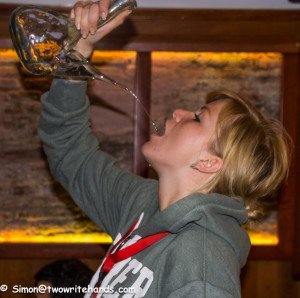
Demonstrating How to Use a Porrón
While we downed our drinks and tapas, Maris demonstrated how to drink wine from a traditional porrón, a glass pitcher with a long spout. Maris actually did the demonstration using water.
The object of the exercise is to tilt your head back, and pour the wine into your mouth without your lips touching the spout. Maris accomplished this like an expert, and made it look easy. Then she encouraged the group to try it. As you might imagine, I was glad I too opted to attempt the feat with water.
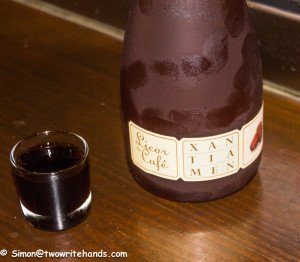
A Final Shot
The evening ended at a friendly but noisy bar with music and pool tables. We were treated to a free shot of a delicious coffee liqueur that slipped down very smoothly after all the beer and salty food.
Although the drink and tapas discounts for our tour group were tempting, we were pleasantly full and feeling mellow. So we left the younger folks to party on, and headed back to our accommodations.
Simon and I are adventurous travelers, and open to finding a city’s culinary treasures as we explore. However, it’s sometimes fun to let go and allow ourselves to have a local expert lead us to the next WOW.
Tickets for the two-and-a-half hour Tapas Experience cost $16.00, and $14.00 for students 18 or older. Included in the ticket price are several tapas and a drink, as well as discounts at all the bars.
Visit the Sandeman’s New Barcelona Tours website for ticket information.
Our heartfelt appreciation goes out to Sandeman’s New Barcelona Tour, whose generosity made this article possible. As always, all opinions are entirely my own.




Maris definitely knows her stuff. I’ll pass the second part of your comment on to Mr. TwoWriteHands. 🙂
Maris looks to be quite the expert with the parron. A great kodac moment captured by Mr two right hands.